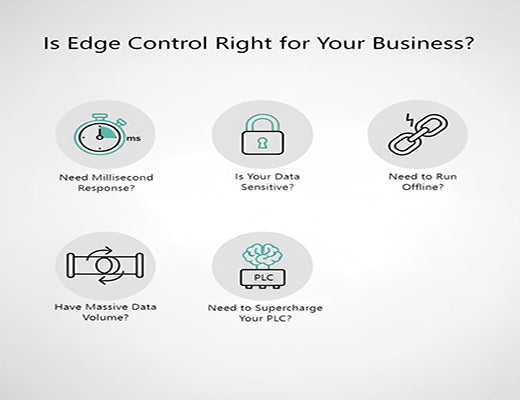
Is Edge Control Right for Your Business? A 5-Point Checklist
|
|
Time to read 5 min
|
|
Time to read 5 min
This guide provides a simple 5-point checklist to help you determine if edge control is the right strategic investment for your business. We'll walk you through key operational questions related to response time, data privacy, and operational resilience. If you answer "yes" to two or more of these questions, it's a strong indication that an edge control architecture can deliver a significant return on investment by making your operations faster, smarter, and more resilient.
Edge control is a powerful but specific solution; this checklist helps you identify if you have the right problems for it to solve.
The checklist focuses on five key business drivers: the need for millisecond-level response, data sensitivity, operational resilience during outages, high data volume, and the desire to add intelligence to existing machinery.
Answering "yes" to these questions indicates that traditional cloud-based or manual control methods are likely costing you money in lost efficiency, downtime, and high operational expenses.
An industrial edge gateway is the hardware that makes the solutions to these problems possible.
You've heard the buzz about smart factories and real-time automation. You've probably heard terms like "edge computing" and "AI." It all sounds promising, but it can be hard to cut through the hype and figure out what it actually means for your business, on your factory floor.
How do you know if you actually need this new technology?
Let's be clear: edge control is not a solution for every problem. It is a powerful tool designed to solve a specific set of high-stakes industrial challenges. The good news is that identifying whether you have these challenges is a straightforward process. This 5-point checklist will act as your guide.

Ask yourself these five questions about your operations. The more times you answer "yes," the stronger the business case for implementing edge control.
Think about your fastest-moving process. A high-speed conveyor belt, a robotic arm, a safety system. If a decision needs to be made and an action needs to be taken in milliseconds, you have a latency problem that the cloud cannot solve.
Consider the data your machines produce. Is it proprietary process information, sensitive quality control data, or footage from a secure area? If this data leaving your facility to be processed on a third-party cloud server makes your security team nervous, you have a data privacy problem.
Imagine your facility's primary internet connection is cut. Does your entire "smart" system grind to a halt? If your production line or critical monitoring system is completely dependent on a stable internet connection to the cloud, you have a reliability problem.
Look at your most data-intensive assets, like high-resolution cameras for quality inspection or high-frequency vibration sensors. If the cost of streaming all that raw data 24/7 over a cellular connection or to the cloud is prohibitively expensive, you have a bandwidth problem.
Your PLCs are reliable workhorses for basic logic, but they can't analyze a video feed or run a predictive algorithm. If you want to add advanced, data-driven capabilities to your existing automation systems without a costly and risky "rip and replace" of your PLCs, you have an integration problem.

The 'aha!' moment is when you realize that a single piece of hardware is the solution to all of these challenges. A powerful industrial edge gateway, like the Robustel EG5120, is the physical platform that makes edge control a reality. It provides the on-site processing power to make instant decisions, the open software environment to run intelligent applications, and the industrial I/O to connect and command your existing machinery, all while keeping your data secure and your operations resilient.

If you answered "yes" to two or more of the questions on this checklist, you have a clear and compelling business case for exploring an edge control solution. You are likely leaving money on the table in the form of lost efficiency, unacceptable risk, or excessive operational costs. By moving intelligence to the edge, you can directly address these core challenges and build a foundation for a more competitive and profitable future.
Further Reading:
A1: It depends on how critical that one question is. For example, if your only "yes" was for the need for a millisecond response time, but that response is for a mission-critical safety system, then edge control is not just worth it; it's a requirement.
A2: It helps by processing all sensitive data (like camera feeds or proprietary production data) on-premise, directly on the edge gateway. Only anonymized, metadata-level results (e.g., "defect count: 5," "process deviation: 2%") need to be sent to the cloud. Your raw, sensitive data never leaves your facility.
A3: The best way to start is to pick one of the problems from the checklist and address it with a small-scale proof-of-concept. For example, connect an EG5120 to a single camera on your production line to test a visual inspection application. This allows you to demonstrate the value quickly and build a case for a wider rollout.